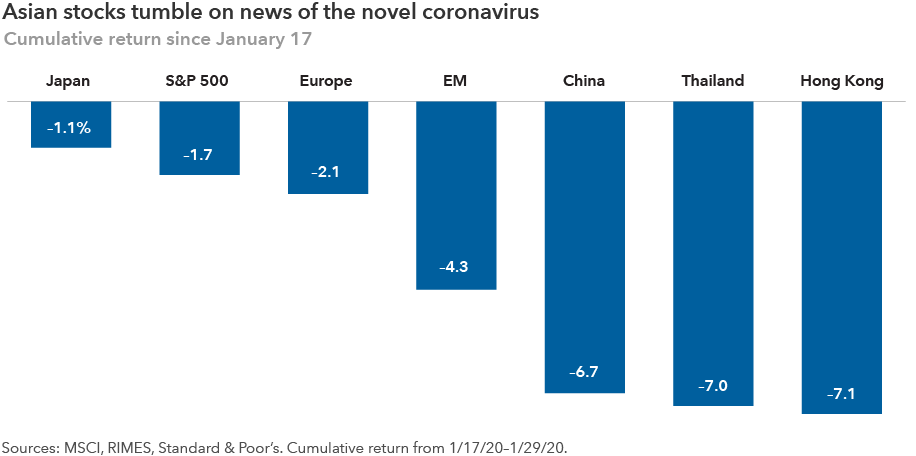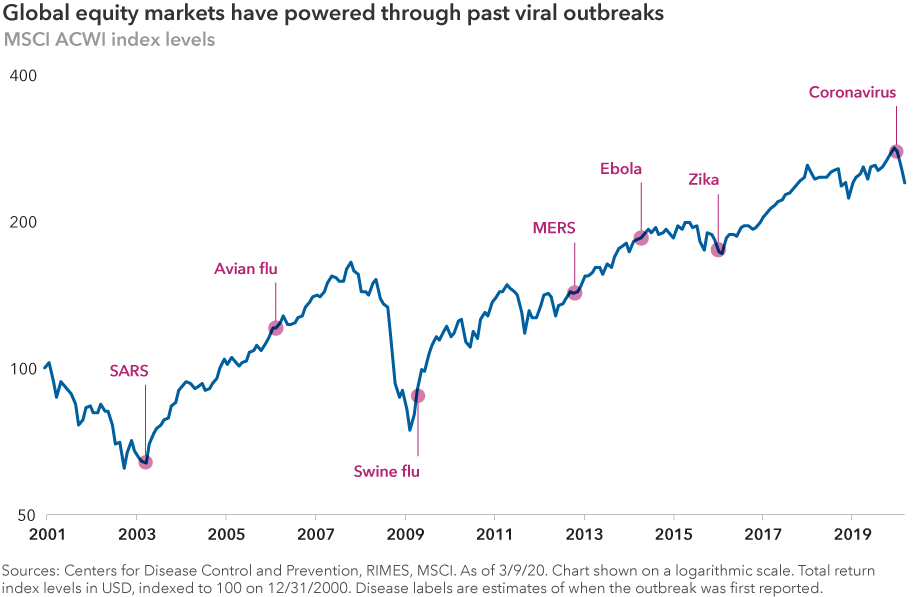Chart in Focus
Market Volatility
- China likely to see flat to negative growth with disruption from coronavirus
- The global economy will likely suffer from China’s impact
- Investors should brace for continued market volatility
Global stocks have fallen sharply following confirmation that the coronavirus has spread to Italy, South Korea and Iran, raising fresh questions about the potential impact on global economic growth and business sector supply chains dependent on China.
After reaching a record high on February 17, the S&P 500 Composite Index has declined by 12%, as of February 27, suffering its first market correction since 2018.
A rising number of infections in Europe, in particular, has prompted markets to re-evaluate concerns about a global pandemic, even though the number of reported cases in mainland China has declined since news reports about the outbreak accelerated around January 17.
“Until this week, the consensus market view of the coronavirus has been fairly benign, but now as it spreads beyond Asia, investors are clearly taking it more seriously,” says Capital Group portfolio manager Jody Jonsson. “The market is starting to consider what it means for global trade and travel. The market is worried about recessionary conditions in certain areas, including China, Japan and potentially Europe.”

Is supply chain impact fully priced in?
Given China’s stature as the world’s No. 2 economy, one of the most difficult questions that markets are grappling with is the possible impact on global supply chains, and the corresponding effect on multinationals and economic activity in other countries.
For instance, what happens if China cannot send the intermediate products needed in the U.S. or South Korea or Japan to assemble finished goods? Are there enough truck drivers to move products, and do the ports have enough containers available?
“We know for the past month that most people in China have stayed at home and haven’t returned to factories or offices. I believe China’s economy will experience negative growth in the first quarter, and then it’s just a question of how quickly the country can get back to work,” says Stephen Green, a Capital Group economist based in Hong Kong.
“When we’ve pressed our industry contacts about the timing of workers returning to manufacturing plants and offices, we have heard mid-March,” Green adds. “That is the base case. But I believe that hinges on the number of confirmed coronavirus cases in China continuing to come down and people gaining more confidence in those numbers and returning to work.”
Even then, there are logistical challenges.
Factory operators have to get permission from the local government to reopen, and health inspections have to be done. Many cities and industrial zones can require 15 certificates. Is enough material on hand to make the product and are there enough workers to run the plant at full capacity? Once you’ve produced the product, is there a truck driver to get it to the port and are there workers at the port to load the goods on a ship? All of these questions are incredibly hard to solve at this time.
“So, in my view, I don’t think the Chinese economy will normalize until April at the earliest,” says Green.
Apple, which relies heavily on manufacturing plants in China, is the most prominent example yet of the broad ripple effects of the coronavirus on global business. The iPhone maker warned February 17 that its revenue for the current quarter would fall short of estimates.
Capital Group U.S. economist Jared Franz says that his early research this week shows that computers, electronic equipment and industrial machinery are the three industries most vulnerable to supply chain disruptions from China.
Global investment implications
This poses a potential threat to Europe’s fragile industrial recovery, with Germany the most exposed through trade links. Meanwhile, France and Italy also have significant exposure to China through tourism, services and luxury goods. And Japan, on the brink of another recession, is heavily dependent on China for intermediate goods that go into its manufacturing.
The complexity and timing of this outbreak may make resumption of normal growth more halting and unpredictable. Global supply chains are tighter and more dependent on China than when the SARS outbreak hit the country in 2002 and 2003.
With China now making up almost 20% of global gross domestic product, China’s slowdown from this outbreak will probably have broader impacts than the SARS outbreak.
While the U.S. economy began 2020 in a much stronger position relative to the rest of the world — with very low unemployment, a robust housing market and a confident consumer — it is not immune to China’s slowdown and supply chain problems.

“If the virus spreads further and China’s manufacturing base in not fully functional by April or May at the latest, we could shave half a percentage point from U.S. GDP in the first half of the year,” Franz adds. “And if it lasts longer, the impact could be more severe in the second.”
Leading Chinese officials have said getting the country’s economy up and running again at full strength is a top priority. They have expressed that the coronavirus is a temporary setback to economic growth. So far, stimulus measures from Beijing have included interest rate cuts, more liquidity for small- and medium-sized enterprises and postponement of debt collections.
The virus is taking its toll on business across the world.
Many U.S.-based airlines have canceled flights to the country. And some companies are lowering earnings guidance for 2020, including some of the world’s biggest cruise line operators and consumer goods makers.
Some companies are opting out of planned conferences in places such as San Francisco and New York as fear of the virus spreads.
“In some ways, the impact is greater on certain companies outside of China — obviously, airlines and cruise companies fall into that category,” says Jonsson. “But it’s also providing a boost to some industries, especially e-commerce and gaming companies. As more people stay home, you’re seeing massive increases in the consumption of home entertainment and online shopping activities.”
This is certainly the case for Chinese technology giant Tencent, which operates one of the world’s largest mobile video game and social media platforms.
Adds Jonsson, “There are a number of industries where I've decided to wait and see how this plays out. For example, when it comes to luxury goods companies or travel-related companies, I think we have time to observe how widespread this situation becomes before making any big decisions in those areas.”
Investing outside the United States involves risks, such as currency fluctuations, periods of illiquidity and price volatility, as more fully described in the prospectus. These risks may be heightened in connection with investments in developing countries. Small-company stocks entail additional risks, and they can fluctuate in price more than larger company stocks.
The MSCI ACWI is a free float-adjusted market capitalization-weighted index that is designed to measure equity markets results in the global developed and emerging markets, consisting of more than 40 developed and emerging market country indexes.
The MSCI Emerging Markets Investable Market Index (IMI) is a free float-adjusted market capitalization-weighted index that is designed to measure results of the large-, mid- and small-capitalization segments of more than 20 emerging equity markets.
Investors cannot invest directly in an index. MSCI has not approved, reviewed or produced this report, makes no express or implied warranties or representations and is not liable whatsoever for any data in the report. You may not redistribute the MSCI data or use it as a basis for other indices or investment products.
Standard & Poor’s 500 Composite Index is a market capitalization-weighted index based on the results of approximately 500 widely held common stocks. Standard & Poor’s 500 Composite Index (“Index”) is a product of S&P Dow Jones Indices LLC and/or its affiliates and has been licensed for use by Capital Group. Copyright © 2020 S&P Dow Jones Indices LLC, a division of S&P Global, and/or its affiliates. All rights reserved. Redistribution or reproduction in whole or in part is prohibited without written permission of S&P Dow Jones Indices LLC.
Our latest insights
-
-
Economic Indicators
-
Demographics & Culture
-
Emerging Markets
-
related insights
-
Asset Allocation
-
Global Equities
-
Dividends
Never miss an insight
The Capital Ideas newsletter delivers weekly insights straight to your inbox.
Statements attributed to an individual represent the opinions of that individual as of the date published and do not necessarily reflect the opinions of Capital Group or its affiliates. This information is intended to highlight issues and should not be considered advice, an endorsement or a recommendation.
 Jody Jonsson
Jody Jonsson
 Stephen Green
Stephen Green
 Jared Franz
Jared Franz